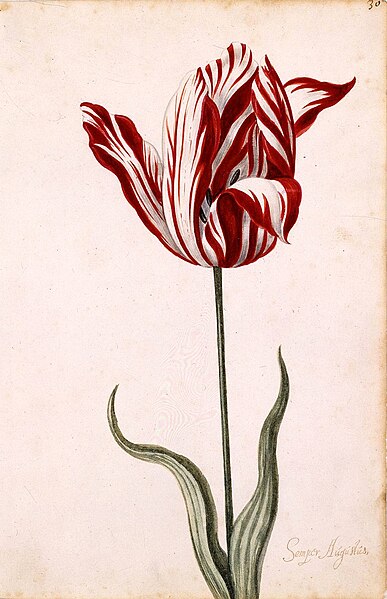Tulipa

With Jurisdynamics reporting in part this week from Amsterdam, the taxon of the week is genus Tulipa.
 The much beloved tulip is the unofficial symbol of the Netherlands and the national flower of Iran and Turkey. The name tulip comes from dulband, the Persian word for turban, suggestive perhaps of the flower's shape. It is also the subject of the celebrated story of tulip mania, the economic madness that gripped the Dutch in the seventeenth century and prompted speculators to bid up the price of tulips, especially variegated varieties, to astronomical levels. The price for a single specimen of the Semper Augustus, depicted here, is said to have reached 6,000 florins, 40 times the average annual income of 150 florins.
The much beloved tulip is the unofficial symbol of the Netherlands and the national flower of Iran and Turkey. The name tulip comes from dulband, the Persian word for turban, suggestive perhaps of the flower's shape. It is also the subject of the celebrated story of tulip mania, the economic madness that gripped the Dutch in the seventeenth century and prompted speculators to bid up the price of tulips, especially variegated varieties, to astronomical levels. The price for a single specimen of the Semper Augustus, depicted here, is said to have reached 6,000 florins, 40 times the average annual income of 150 florins.The story of tulip mania makes good reading, from Deborah Maggoch's melodrama, Tulip Fever, to Anna Pavord's soberly entertaining and informative account in The Tulip. The truth is somewhat less exciting. The scholarly consensus appears to suggest that stories of the Dutch tulip mania are perhaps themselves the subject of a mania in their own right. See, e.g., Mike Dash, Tulipomania (1999); Peter M. Garber, Tulipmania, 97 J. Pol. Econ. 535 (1989). These skeptics believe that tulip pricing in the Netherlands of the seventeenth century in fact behaved as a rational economic model would predict.
 Whatever the historical truth and contemporary economic significance of tulip fancy in the Netherlands, the biological mechanism triggering the mania is now known. Many of the variegated varieties that attracted Dutch admiration gained their delicately feathered patterns from a viral infection. The mosaic virus responsible for this phenomenon is carried by the peach potato aphid, Myzus persicae. This remains the only instance in which a disease has raised instead of depressed the value of a cultivated plant to humans.
Whatever the historical truth and contemporary economic significance of tulip fancy in the Netherlands, the biological mechanism triggering the mania is now known. Many of the variegated varieties that attracted Dutch admiration gained their delicately feathered patterns from a viral infection. The mosaic virus responsible for this phenomenon is carried by the peach potato aphid, Myzus persicae. This remains the only instance in which a disease has raised instead of depressed the value of a cultivated plant to humans. And then there is this perspective. Rather than speculating about tulip mania and pondering whether the contemporary world is susceptible to the sort of mass economic hysteria that tulip mania supposedly embodied, perhaps we would do well simply to admire the tulip for what it is: a beautiful flower.
And then there is this perspective. Rather than speculating about tulip mania and pondering whether the contemporary world is susceptible to the sort of mass economic hysteria that tulip mania supposedly embodied, perhaps we would do well simply to admire the tulip for what it is: a beautiful flower.












0 Comments:
Post a Comment
<< Home